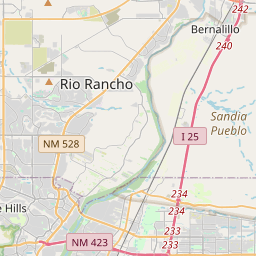Las Placitas (1)







© OpenStreetMap contributors
Side 1
Humans have lived in the Sandia Mountains for thousands of years. The Spanish settled this area by 1767 when Governor Pedro Fermín established the land grant known as San Antonio de las Huertas. The area was named “Las Placitas” for the many local villages. Descendants of the stockmen and farmers who first settled the grant still live in the vicinity. Several nearby sites of Puebloan and Spanish origin are listed in the State Register of Cultural Properties.Side 2
Por milenios, los seres humanos han ocupado las montañas Sandia. En 1767, el Gobernador Pedro Fermín de Mendinueta, concedió La Merced de San Antonio de las Huertas, en la cual estaban ubicadas varias aldeas o “placitas”, dando el orígen a su nombre actual. Sus primeros pobladores fueron ganaderos y agricultores, cuyos descendientes aún viven en su vecindad
Loading...
Searching for other points of interest within 3 miles of this location.New Mexico was one of the last territories to become a state, gaining statehood in 1912. Before that, it had been part of the Spanish Empire, Mexico, and the United States Territory of New Mexico.
About Sandoval County
Sandoval County Timeline
Sandoval County, located in the state of New Mexico, has a rich and diverse history that spans several centuries. The area was originally inhabited by various Native American tribes, including the Pueblo people, who left behind archaeological evidence of their settlements and developed sophisticated agricultural techniques. Spanish explorers arrived in the 16th century and established missions in the region, marking the beginning of European influence in Sandoval County.
In the 19th century, the construction of the Santa Fe Trail brought increased trade and settlement to the area. As American settlers arrived, conflicts between the newcomers and the Native American tribes escalated, leading to the New Mexico Wars. These conflicts ultimately resulted in the displacement of the Native peoples and the establishment of American control over the region.
Sandoval County played a significant role in the New Mexico Territory during the Civil War. It was the site of the Battle of Valverde, a major engagement between Union and Confederate forces. Following the war, the area experienced an influx of settlers attracted by the agricultural potential and abundant natural resources of the Rio Grande valley.
In the 20th century, Sandoval County continued to develop and grow. The construction of Interstate 25 and the subsequent expansion of transportation routes brought increased connectivity to the region. Today, Sandoval County is known for its stunning landscapes, including the famous Jemez Mountains and the Valles Caldera National Preserve. It also serves as a popular tourist destination, attracting visitors with its rich cultural heritage, Native American art, and historical landmarks.
In the 19th century, the construction of the Santa Fe Trail brought increased trade and settlement to the area. As American settlers arrived, conflicts between the newcomers and the Native American tribes escalated, leading to the New Mexico Wars. These conflicts ultimately resulted in the displacement of the Native peoples and the establishment of American control over the region.
Sandoval County played a significant role in the New Mexico Territory during the Civil War. It was the site of the Battle of Valverde, a major engagement between Union and Confederate forces. Following the war, the area experienced an influx of settlers attracted by the agricultural potential and abundant natural resources of the Rio Grande valley.
In the 20th century, Sandoval County continued to develop and grow. The construction of Interstate 25 and the subsequent expansion of transportation routes brought increased connectivity to the region. Today, Sandoval County is known for its stunning landscapes, including the famous Jemez Mountains and the Valles Caldera National Preserve. It also serves as a popular tourist destination, attracting visitors with its rich cultural heritage, Native American art, and historical landmarks.
Sandoval County Timeline
This timeline provides a glimpse into the major events and milestones that have shaped the history of Sandoval County, New Mexico.
- 1852: Sandoval County is established as one of the nine original counties of the New Mexico Territory.
- 1883: The county seat is moved from Bernalillo to Cuba.
- 1918: Coyote Dam is constructed, providing irrigation water for local farmers.
- 1944: The town of Jemez Springs is incorporated.
- 1974: Sandoval County Historical Society is founded to preserve and promote the county's history.
- 1985: The Jemez Pueblo is designated a National Historic Landmark.
- 1998: Petroglyph National Monument is established within the county's borders.
- 2011: The village of Rancho de San Juan is incorporated.